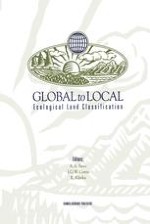1996 | OriginalPaper | Buchkapitel
The ITE Land Classification: Providing an Environmental Stratification of Great Britain
verfasst von : R. G. H. Bunce, C. J. Barr, M. K. Gillespie, D. C. Howard
Erschienen in: Global to Local: Ecological Land Classification
Verlag: Springer Netherlands
Enthalten in: Professional Book Archive
Aktivieren Sie unsere intelligente Suche, um passende Fachinhalte oder Patente zu finden.
Wählen Sie Textabschnitte aus um mit Künstlicher Intelligenz passenden Patente zu finden. powered by
Markieren Sie Textabschnitte, um KI-gestützt weitere passende Inhalte zu finden. powered by
The surface of Great Britain (GB) varies continuously in land cover from one area to another. The objective of any environmentally based land classification is to produce classes that match the patterns that are present by helping to define clear boundaries. The more appropriate the analysis and data used, the better the classes will fit the natural patterns. The observation of inter-correlations between ecological factors is the basis for interpreting ecological patterns in the field, and the Institute of Terrestrial Ecology (ITE) Land Classification formalises such subjective ideas. The data inevitably comprise a large number of factors in order to describe the environment adequately. Single factors, such as altitude, would only be useful on a national basis if they were the only dominant causative agent of ecological variation.The ITE Land Classification has defined 32 environmental categories called ‘land classes’, initially based on a sample of 1-km squares in Great Britain but subsequently extended to all 240 000 1-km squares. The original classification was produced using multivariate analysis of 75 environmental variables. The extension to all squares in GB was performed using a combination of logistic discrimination and discriminant functions. The classes have provided a stratification for successive ecological surveys, the results of which have characterised the classes in terms of botanical, zoological and landscape features.The classification has also been applied to integrate diverse datasets including satellite imagery, soils and socio-economic information. A variety of models have used the structure of the classification, for example to show potential land use change under different economic conditions. The principal data sets relevant for planning purposes have been incorporated into a user-friendly computer package, called the ‘Countryside Information System’.
